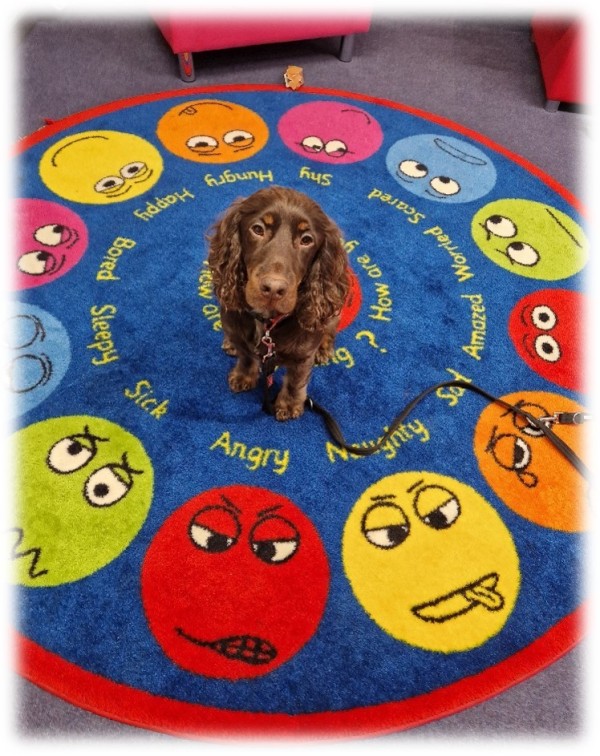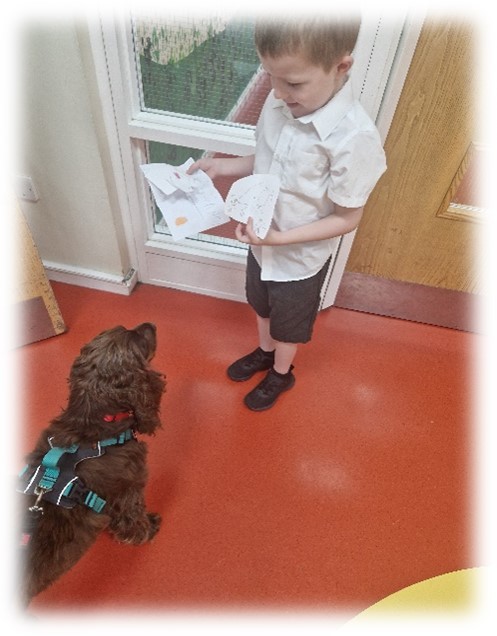Therapy Dog

Research has shown many benefits to therapy and reading dogs in school settings. The Discovery School has introduced the use of a therapy dog into the emotional well-being provision at school. This policy is designed to set out to pupils, parents, staff and visitors the reasons for having a school dog and the rules and responsibilities to ensure the safety of pupils, staff, visitors and the school dog. Although there is a risk in bringing a dog into a school environment, this can be mitigated against with a robust risk assessment to ensure the safety of all pupils, parents, staff and visitors.
Children can benefit educationally and emotionally, increase their understanding of responsibility and develop empathy and nurturing skills through contact with a dog. In addition to these benefits, children take great enjoyment from interactions with a dog.
The benefits of a Therapy Dog
School dogs have been proven to help develop pupils’ reading skills, improve behaviour, attendance, and academic confidence, as well as increasing student understanding of responsibility and in the development of empathy and nurturing skills.
At The Discovery School, we hope that a school dog will be a beneficial addition to our therapeutic offer, in addition to the interventions we already offer and promoting engagement for those children who have found it difficult to access talking therapies in the past.
Animal Assisted Interventions (also known as AAI’s) can:
-
Teach empathy and appropriate interpersonal skills;
-
Help individuals develop social skills;
-
Be soothing;
-
Improve a child’s ability to pick up on social cues which are imperative to human relationships;
-
Therapy dogs have been shown to support emotional regulation through the positive impact on the autonomic nervous system
-
Show that children working with therapy dogs have experienced increased improved motivation for learning, resulting in improved outcomes;
-
Therapy dogs are being used to support children with their social and emotional learning needs, which can also aid literacy development
Research into the effects of therapy dogs in schools shows a range of benefits including:
-
Increase in school attendance;
-
Improved confidence;
-
Decreased pupil anxiety resulting in improvements in learning, such as increases in reading and writing levels;
-
Improved motivation to learn;
-
Enhanced relationships with peers and teachers due to experiencing trust and unconditional positive interactions with a therapy dog;
-
Helping children learn how to express their feelings and enter into more trusting relationships.
-
Increased social skills and self-esteem
-
Teaching responsibility and respect to all life

Confidence benefits
“If children are partnered with a dog to read to, for example, the dog provides comfort, encourages positive social behaviour, enhances self-esteem, motivates speech and inspires children to have fun and enjoy the non-judgemental experience”
Mental Health and Wellbeing benefits
Some children and adults with mental health challenges and psychiatric disorders are known to respond positively to therapy dogs. Patients diagnosed with a range of issues, such as depression, bi-polar disorder, Autism, ADHD, post-traumatic stress disorder (PTSD), and Alzheimer's disease, benefit from their interaction with therapy dogs and other companion animals.
Sometimes, emotional challenges are the result of physical health problems, and therapy dogs can help with those too. Research suggests that patients who are recovering from difficult surgery or a bad accident who participate in animal-assisted therapy may feel less pain. Studies have shown that such interactions can increase the mood-boosting hormone oxytocin and decrease the stress hormone cortisol.
Evidence shows that just by being near a dog when stressed can reduce anxiety. In a survey, 92% of pupils said they felt more relaxed during teaching and learning time when there was a dog in the classroom. When children are more relaxed and less stressed, they’re going to learn more.
Behaviour benefits
Researchers report that pupils can identify with animals, and with empathy for the dog, can better understand how classmates may feel. It was found that violent behaviour in participating pupils declined by 55%, and general aggression went down 62%. In a controlled study, pupils were found to have fewer disciplinary referrals in schools with a dog than schools without. Pupils’ behaviour improved toward teachers, and pupils also showed more confidence and responsibility.

The following information has been taken from a range of sources to provide further detail about the benefits of having a dog in school:
Education
Reading programmes with dogs are doing wonders for some pupils. Children who might be embarrassed to read aloud to the class or even adults are likely to be less scared to read to a dog. “It might be less stressful for a child to read aloud to a dog than to a teacher or a peer. After all, a dog won’t judge or correct you. Dogs are used to encourage struggling readers to practise reading aloud. With the presence of a calm and well-trained dog, pupils find social support and peer interaction. Dogs are incredibly calm and happy to have pupils read to them or join a group of children in the library whilst they are having a book reading session. Dogs give unconditional acceptance, as they are non-judgmental, which is especially crucial to struggling, emerging readers. The dogs also provide confidence to children as they do not make fun of them when they read, but above all they make amazing listeners, providing the children with a sense of comfort and love. Research has proved that pupils who read to dogs show an increase in reading levels, word recognition, a higher desire to read and write, and an increase in intrapersonal and interpersonal skills among the pupils they mix with.
Social Development
Dogs in school offer an opportunity for improving social development. They are especially useful for teaching pupil’s social skills and responsibility. Schools are using dogs to help older pupils build self-esteem; learn about positive and negative reinforcement, responsibility, and boundaries. Pupils can use dogs to help communicate, teach kindness, and empower pupils. With a dog in school, pupils have the opportunity to learn how to care for the dog; this includes walking and grooming. Research reports that involving pupils in the daily care of a classroom dog is a positive experience, promoting their own daily care. The pupils also learn about responsibility, caring, and sharing when helping each other take care of a dog at school.
Pastoral Care
Therapy Dogs can work with pupils on a one-to-one basis and will especially help those pupils who have been bullied, abused, going through upsetting/difficult times or even scared/phobic of dogs. The dog will bring much joy and help to all the pupils they meet and are happy to provide plenty of hugs to the pupils they are spending time with. Pupils who struggle with social interaction can find a reassuring friend in a dog.
What our children say about our Therapy Dog, Sam.
“I was very nervous to start with when I met Sam, but he’s so good because he doesn’t jump or bite. When can I come and visit him next?”
“Sam is so soft and gentle. His ears are really fluffy”
“When I done Sand Play, Sam just curled up by my feet while I played. He is so soft and gentle.”
“Sam is just like my dog at home. It’s so nice having a dog in school”
“I played with the ball with Sam and he ran so fast! He jumped up and caught the ball!”
“Sam really helped me when I wasn’t feeling well. Stroking him helped me to calm down and not worry about feeling unwell.”





